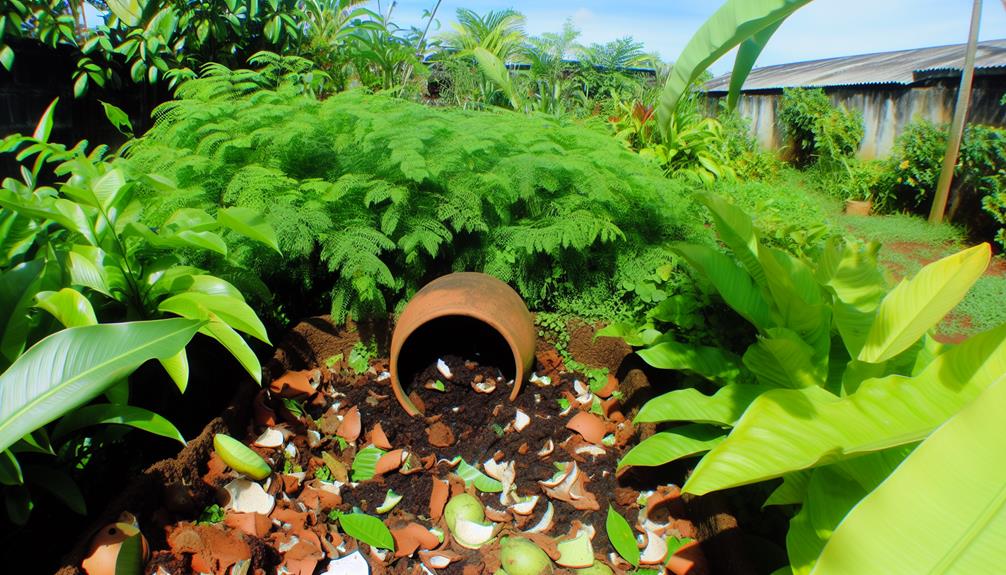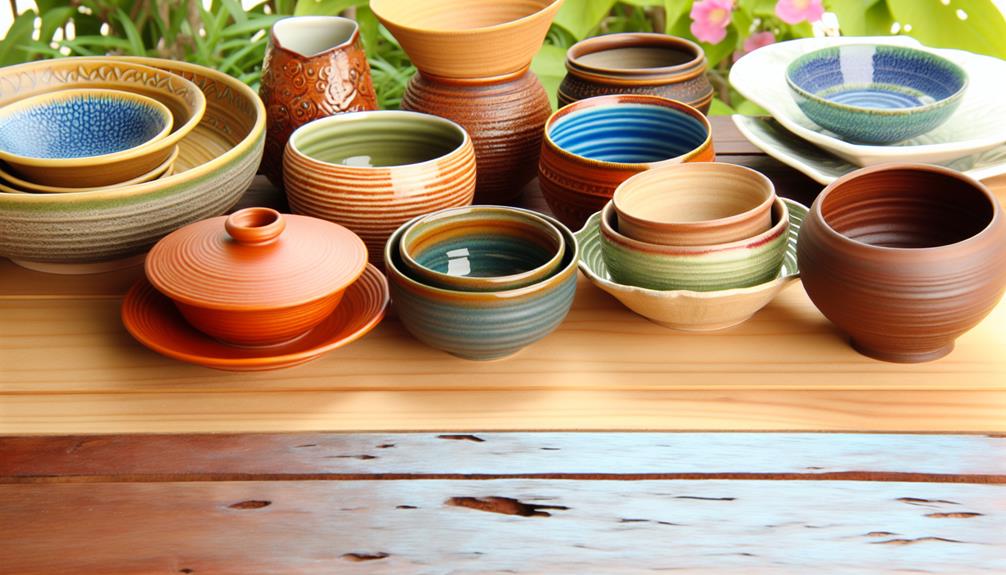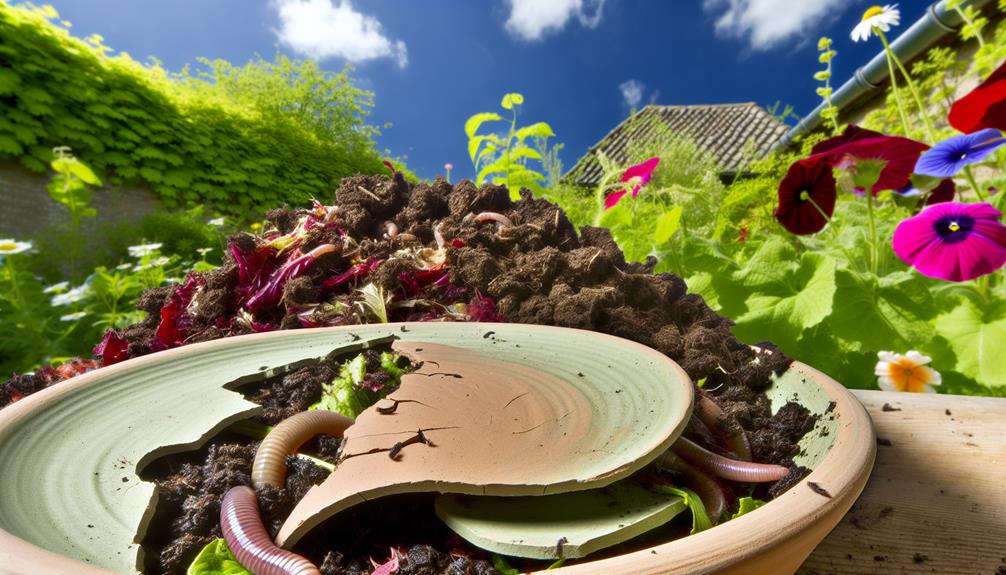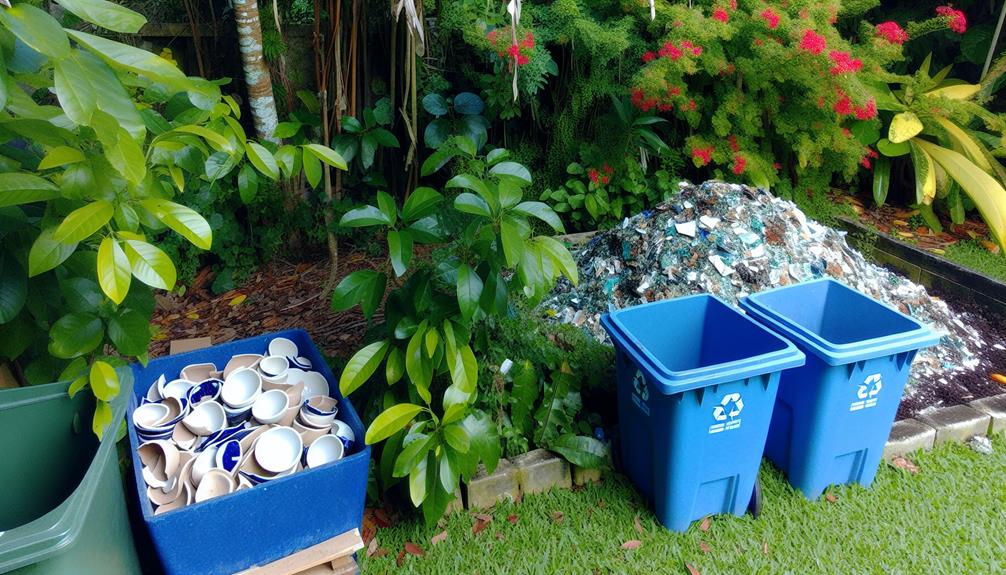

You can’t compost ceramic because it’s a non-biodegradable material that won’t break down like organic waste. Ceramics take thousands of years to decompose due to their durability and resistance to microbial activity. Including ceramics in compost can complicate and reduce the efficiency of the process.
Instead, consider recycling ceramics at local centers or repurposing them in creative ways. You can donate intact ceramics to art classes, thrift stores, or use broken pieces in garden projects. By understanding these options, you’ll find sustainable ways to handle ceramic waste. There’s more you can learn to manage it effectively.
To understand the basics of composting, you need to know how organic materials break down into nutrient-rich soil. Composting is a natural process where organic waste, like kitchen scraps and yard clippings, decomposes with the help of microorganisms. This creates a rich, fertile material you can use to improve your garden soil.
You’ll need the right balance of green materials and brown materials. Green materials include things like vegetable peels, coffee grounds, and grass clippings. They’re rich in nitrogen, which is essential for microbial growth and activity.
When starting your compost pile, layer these green materials with brown materials, such as dried leaves, straw, and cardboard, which are high in carbon. The mix of nitrogen and carbon feeds the microorganisms, enabling them to break down the organic waste efficiently.
It’s important to maintain proper moisture and aeration. Turn your compost pile regularly to make sure it gets enough oxygen, preventing it from becoming a smelly mess. With patience and care, your compost pile will transform into rich, dark soil that’s perfect for gardening.
This process not only recycles waste but also fosters a sense of contributing to a sustainable community.
Also Read: Can You Compost Wood Scraps?
Ceramic is a versatile material made from clay that’s been shaped and hardened through high-temperature firing. Its origins date back thousands of years, making it one of the oldest human-made substances. Throughout ceramic history, it’s been used for everything from ancient pottery to modern-day tiles and sanitary ware.
You might find ceramics in your kitchen as plates, bowls, and mugs, or in your bathroom as tiles and fixtures. They’re prized for their durability and heat resistance, making them ideal for both decorative and practical uses.
Here’s a quick guide to understand the basics of ceramic:
| Property | Description |
|---|---|
| Composition | Made from clay or similar materials |
| Process | Shaped and hardened through high-temperature firing |
| Durability | Extremely durable, often lasts for centuries |
| Common Uses | Pottery, tiles, sanitary ware, and kitchenware |
Ceramic uses have evolved, but the basic principles remain the same. You can appreciate the connection to ancient artisans every time you hold a ceramic mug or walk on ceramic tiles. These materials connect us through time, showcasing human ingenuity and the enduring nature of this ancient craft. Understanding ceramics helps you see their value and longevity, offering a glimpse into a rich and shared cultural heritage.
Also Read: Can You Compost Cauliflower Scraps?
You’ll find a variety of ceramics, each with unique properties and uses, ranging from earthenware to porcelain. Understanding these types can help you determine how to handle them, especially when considering their end-of-life options.

Porcelain types are known for their delicate appearance and high durability. They’re often used for fine china and decorative items. Porcelain is fired at very high temperatures, which makes it strong and less porous compared to other ceramic types.
Stoneware varieties, on the other hand, are more robust and thicker. They’re commonly used for everyday items like mugs and baking dishes. Stoneware is fired at a slightly lower temperature than porcelain but is still quite durable and resistant to chipping.
Earthenware is another common type of ceramic, typically more porous and less durable than stoneware and porcelain. It’s often used for pottery and decorative pieces. Earthenware is fired at lower temperatures, making it more susceptible to damage and wear over time.
Also Read: Can You Compost Cedar Chips?
Understanding ceramic biodegradability is crucial for making informed environmental choices. Unlike organic materials, ceramics take an extremely long time to break down, posing challenges for composting.
You’ll need to take into account the environmental impact and explore alternative composting methods to manage ceramic waste effectively.
Breaking down ceramic materials is a slow process that can take thousands of years due to their non-biodegradable nature. When you think about the decomposition of ceramics, it’s important to take into account that these materials resist natural breakdown processes. Weather influence plays a role, but it’s minimal compared to how organic materials decompose. Over long periods, weathering can cause slight erosion, but this is hardly noticeable in a human lifetime.
Microbial activity, which is vital for composting organic waste, doesn’t affect ceramics. Microorganisms thrive on breaking down organic material, but ceramics don’t provide the nutrients these microbes need. This means that even with ideal composting conditions, ceramics remain unchanged.
For those of you invested in sustainable living, knowing the timeline of ceramic decomposition is essential. It helps you make informed choices about what to include in your compost. If you’re looking for ways to reduce waste, consider repurposing or donating old ceramics instead of composting them. These actions can help you build a more sustainable lifestyle and contribute to a community of like-minded individuals focused on environmental responsibility.
When considering the environmental impact of ceramics, it’s important to recognize their resistance to biodegradation and the long-term implications for waste management. Ceramics don’t break down like organic matter, so tossing them into your compost pile isn’t effective. They’ll remain intact for centuries, contributing to landfill growth and environmental strain.
Here’s a quick comparison to help you understand better:
| Material | Biodegradability |
|---|---|
| Ceramics | Non-biodegradable |
| Food Scraps | Biodegradable |
| Yard Waste | Biodegradable |
| Paper Products | Biodegradable |
| Metals | Non-biodegradable |
Clearly, ceramics don’t fit in with typical compost pile materials like food scraps and yard waste. While organic matter enriches the soil, ceramics won’t. They just occupy space without contributing to the nutrient cycle. When you include non-biodegradable items in your compost, it can complicate the composting process and reduce the efficiency of breaking down truly compostable materials.
If you’re looking for composting alternatives for ceramics, consider repurposing or recycling them instead. Ceramics don’t break down like organic materials, but they can still be environmentally managed effectively.
Repurposing broken ceramics as drainage material in plant pots or as mosaic pieces for art projects is a creative way to give them a second life.
Recycling is another viable option. Many facilities accept ceramics, which are crushed and used in road construction or as building materials. Check with your local recycling center to see if they take ceramics.
When it comes to organic waste, vermicomposting offers significant benefits. This method uses worms to break down food scraps into rich compost. It’s a fantastic way to manage kitchen waste and enrich your garden soil.
Unlike ceramics, organic waste is perfect for vermicomposting due to its biodegradability.
Anaerobic digestion is another method for managing organic waste. It involves breaking down materials in an oxygen-free environment, producing biogas and nutrient-rich digestate.
While ceramics can’t be composted, these methods help you handle other waste types efficiently, ensuring your sustainability efforts are well-rounded and effective.
Also Read: Can You Compost Broad Beans?
When considering the environmental impact of ceramics, you should focus on their non-biodegradable nature, which means they persist in landfills for centuries.

To mitigate this, recycling ceramics can be more beneficial than disposal, but it requires specialized processes.
Understanding these aspects helps you make more informed decisions about handling ceramic waste.
Ceramics don’t break down naturally, leading to long-lasting environmental pollution. Unlike organic materials that decompose, ceramics persist in the environment for centuries. This contributes to the problem of non-biodegradable waste. When you discard ceramic items, they often end up in landfills. Over time, this adds to landfill overflow, creating significant environmental challenges.
You might think plastic pollution is the main concern, but ceramics are just as problematic. They don’t degrade and take up space indefinitely. While they don’t release toxins like some plastics, their sheer volume is an issue. Imagine a landfill filled with broken mugs and plates that never disappear. This isn’t just an eyesore but a serious environmental burden.
To address this, consider alternatives. Repurpose old ceramics instead of throwing them away. Use broken pieces in garden paths or as drainage material in plant pots. You can also support companies that focus on sustainable materials.
Instead of letting ceramics pile up in landfills, recycling them can significantly reduce their environmental impact. When ceramics end up in landfills, they don’t break down, contributing to landfill issues that affect the environment negatively. By recycling ceramics, you’re taking an active step to minimize waste and conserve resources.
Recycling benefits the environment by reducing the need for raw materials, which means less energy consumption and fewer emissions from manufacturing processes. You’re also helping to decrease the volume of waste in landfills, which are already overburdened and can lead to soil and water contamination.
To recycle ceramics, check if your local recycling programs accept them. Some facilities mightn’t take ceramics, but specialty recycling centers often do. If recycling isn’t an option, consider repurposing broken ceramics as mosaic materials or donating intact items to thrift stores.
Taking these steps fosters a community that values sustainability and encourages others to think about their environmental impact. By actively participating in recycling efforts, you’re contributing to a collective movement towards a greener future.
You might wonder why ceramics can’t go into the compost bin despite their natural origins. While ceramics are made from natural materials like clay, they undergo a high-temperature firing process that changes their composition. This transformation makes them non-biodegradable and unsuitable for composting. Here’s why:
Understanding these points helps you make better waste management decisions. By keeping ceramics out of your compost bin, you ensure that your compost remains effective and beneficial for your garden.
Given that ceramics aren’t compostable, let’s explore some effective alternatives for managing ceramic waste. While tossing broken ceramic pieces into the trash might be convenient, there are more eco-friendly options you can consider.
Recycling is a great first step. Some recycling centers accept ceramics, so check with your local facility. If they don’t, see if nearby pottery classes or ceramic art studios could use your unwanted pieces for practice or projects. Additionally, donating intact ceramics such as dishes or decorative items to thrift stores can give them a second life.
Here’s a handy table to summarize your options:
| Alternative | Description |
|---|---|
| Recycling | Check local recycling centers for ceramic acceptance. |
| Pottery Classes | Donate to pottery classes for practice material. |
| Ceramic Art Studios | Offer pieces to art studios for creative projects. |
| Thrift Stores | Donate intact ceramics to thrift stores for resale. |
| Community Groups | Post in local groups to find someone who may need them for various uses. |
Broken or unused ceramics can be transformed into unique and functional items with a bit of creativity and effort. Here are some engaging ways to breathe new life into your ceramics:
Also Read: Can You Compost Bread?
Recycling ceramics can be a bit challenging, but there are several effective methods to make sure they don’t end up in landfills. One option is to contact your local recycling center. Many centers have special programs for ceramic items, especially if you live in an area with a strong focus on green living. They mightn’t accept ceramics in regular curbside bins, but they often have drop-off points.

You can also get creative with urban gardening. Broken ceramic pieces can be used as drainage material at the bottom of plant pots or mixed into garden soil to improve aeration.
Another option is to check with local art schools or community centers. Artists and educators sometimes use broken ceramics for mosaics and other art projects.
If you’re part of a community that values sustainability, consider organizing a ceramics recycling drive. Collect unwanted ceramics from neighbors and take them to a specialized recycling facility together. This not only helps the environment but also fosters a sense of community.
Lastly, some companies specialize in recycling construction materials, including ceramics. A quick online search can help you find a service in your area, ensuring your broken ceramics find a new purpose.
Yes, you can repair broken ceramics before disposal. Explore repair techniques and restoration methods like using adhesive or kintsugi. By restoring items together, you help preserve cherished memories and create a stronger community bond.
If you mistakenly add ceramics to compost, they can cause soil contamination and nutrient imbalance. It’s important to keep your compost clean to guarantee your garden community thrives and stays healthy.
Yes, there are eco-friendly alternatives designed with biodegradable materials. You’ll find ceramic products made from natural, sustainable resources. Choosing these options helps you contribute to a greener community and feel connected to like-minded individuals.
When handling broken ceramic pieces, you’ve got to be cautious of sharp edges that can cause cuts. Wear gloves and a mask to avoid dust inhalation. Stay safe, and you’ll protect yourself from any potential harm.
You can definitely repurpose ceramic items for gardening or landscaping projects. Create beautiful mosaic designs or use broken pieces for garden edging. Embrace your creativity and transform your space into a unique, community-inspired haven.
You can’t compost ceramics because they’re not biodegradable. Instead, consider reusing or recycling them.
Use broken pieces in art projects or as drainage in plant pots. Check with local recycling programs to see if they accept ceramics.
By exploring these alternatives, you’ll reduce waste and make a positive environmental impact.
Remember, composting is for organic materials, so always think creatively about how to manage non-compostable items like ceramics.
